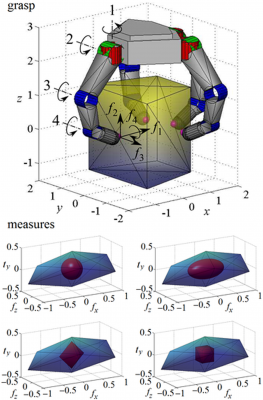Abstract

This paper proposes a new grasp force efficiency (GFE) measure that considers not only contact point locations but also the hand configuration and mechanism. GFE evaluates the largest wrench applied to the object that the grasp can resist with unit contact forces. Traditional GFE measures depend solely on the contact point locations without considering how the unit contact forces are generated. Intuitively, however, the actuators’ effort required to generate unit contact forces depends on the hand configuration and mechanism and therefore should affect the grasp efficiency. For example, generating a unit contact force with an under-actuated finger would be more difficult than with a fully actuated finger. Our new GFE measure addresses this issue and is potentially useful for hand mechanism design as well as grasp planning. We also present a novel geometry-based iterative algorithm for computing the generalized penetration distance of a point in an arbitrary convex set. The algorithm allows unified and accurate computation of the new and traditional GFE measures with various criteria without linear approximation. Other applications of the algorithm include penetration depth computation of two convex objects for physics simulation.
Copyright Notice
The documents contained in these directories are included by the contributing authors as a means to ensure timely dissemination of scholarly and technical work on a non-commercial basis. Copyright and all rights therein are maintained by the authors or by other copyright holders, notwithstanding that they have offered their works here electronically. It is understood that all persons copying this information will adhere to the terms and constraints invoked by each author’s copyright. These works may not be reposted without the explicit permission of the copyright holder.